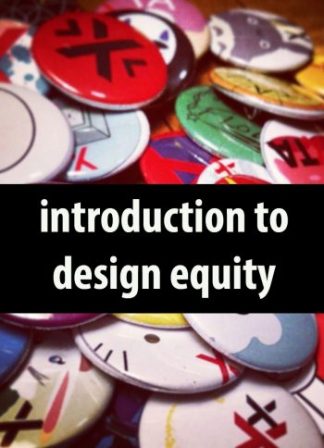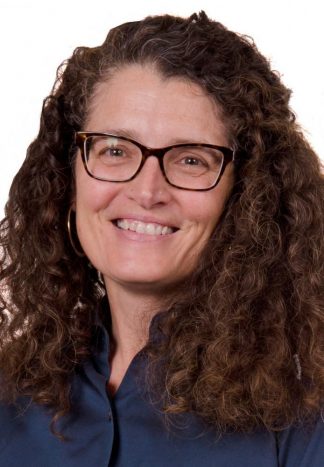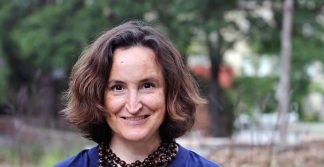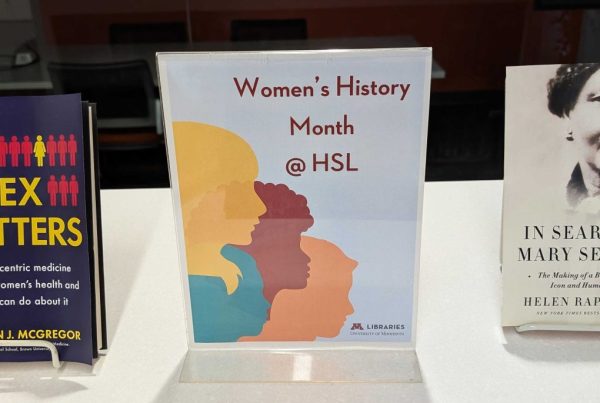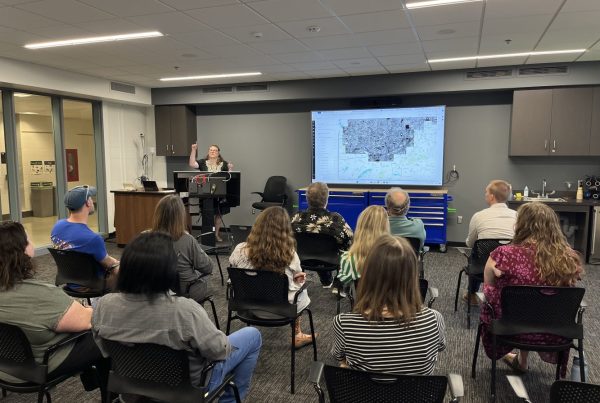Allison Campbell-Jensen
Standard textbooks don’t suit everybody in academia. The fit may be awkward — or there’s a hole where a textbook should be. Plus, there’s the issue of cost. What can faculty members do? With the help of the Libraries, they can develop textbooks their way.
New field
Everything changes quickly in an emerging field such as design equity, which examines how environmental design of public spaces prevents or helps people access the resources — health, transportation, information — that they need in public life. The field became more relevant after the recent tragic death of George Floyd in Minneapolis and protests that followed.
Still, starting a few years ago to teach a design equity course that attracts not only design majors but also students from other fields, Kristine Miller, a Landscape Architecture Professor within the College of Design, had been presenting a mosaic of recent articles and other resources for her students.
After three years of Moodling around, she decided to write her own textbook.
New focus
Something outside the typical introduction to biology textbook also was needed by Teaching Assistant Professor Charlie Willis in the College of Biological Sciences. Rather than focusing on cell biology or organisms, he prefers a big picture approach, emphasizing evolution and environment.
To arrive there, he’s been switching between a couple of existing open-source textbooks. Yet, to serve the students, he says he also had to dig for information on “subjects like the evolution of cooperation, or altruism, evolution of sex, or sexual selection, that aren’t really covered in those general books.”
To better reach his 250 to 300 introductory-level students, Willis decided to use existing open-source materials to create a new open textbook designed so he could teach Intro to Biology his way.
Self-publishing help from the Libraries
Anyone in the U community can use the U’s version of Pressbooks to self-publish, to create their own book or online portfolio. Yet when a faculty member wishes to develop their own book for classroom use, they may need a partner to clear the way, like the Libraries’ eLearning Support Initiative.
“When someone wants to do a project like that, they become like a client and we customize our support to meet their needs,” says Kristi Jensen, Program Development Lead for the eLearning Support Initiative.
Jensen’s collaboration meant that Willis’s textbook project continued to move forward even through the disruptive transition to online learning caused by steps to contain COVID-19 pandemic.
“It has really been a positive experience,” says Willis. “The library and Kristi’s team have just been exceptional in helping me navigate this and pull it together. So I would encourage any other faculty or instructor to consider it for their course.”
For summer term students, he will introduce the textbook as a supplement, with hopes of gaining feedback. He plans to follow this soft debut with a fall launch of the textbook.
Accessible and affordable
His primary impetus behind the effort: for the students, the textbook is free. The textbook that Willis used previously had gone from $70 to $90. “It was a good textbook,” he says, “but the cost versus the benefit in my mind wasn’t balancing out” particularly for those not majoring in biology.
Jensen says the advantage for students is a key benefit.
“If we are concerned with equity, especially now with the pandemic,” she says, “and we can put quality materials in students’ hands for less or for free, why wouldn’t we want to do that as often as we can?”
And, of course, students have immediate access once materials are published online.
Willis reached out directly to Jensen and team. Other faculty seeking materials to replace textbooks may reach out directly to their subject librarians.
Or faculty can seek aid to create their own open textbook through the Affordable Content grant program, as Miller did. Hers is one of the textbooks recently published with a grant. Because it contained original content, it was published in partnership with the Libraries Publishing Services, which supports the creation of scholarly and academic works by U of MN students, staff and faculty.
For 5 years, the Affordable Content grant program has been supporting faculty and students with affordable options for an average of 20 classes a year. “We’re meeting people where they are,” Jensen says, “pushing back on the idea that education happens because of a traditional textbook.”
A ready resource
Miller was grateful that, when instruction moved online, her students could access her Introduction to Design Equity electronically. “I knew that they had the book, which also meant they had everything they needed to read and watch. Things weren’t locked in their dorm-room or some other place they couldn’t access.”
Also, before the transition to online learning this spring, she and the students were able to have in-person discussions on difficult big topics, such as racism.
In the first chapter of Introduction to Design Equity, Miller writes: “livability awards aside, and official rhetoric about the importance of equity aside, the Twin Cities is still one of the worst places in the country to be Black or Native American. That’s right, one of the worst. And this is on important measures like education, health, and jobs.”
Because of the need for these deep conversations between students and local experts, Miller doesn’t think the class can ever be fully online. Yet traditional textbook publishers would be unlikely to respond to the relatively small audience in this emerging field, so Miller wrote her own up-to-date textbook, richly illustrated, and linked to online resources.
The book also is in her voice, reflects her perspective, and remains under her control. She is writing a new concluding chapter now.
Open to all
“I don’t have the skills or the knowledge base to create an open source, online textbook,” Miller says. Fortunately, she doesn’t have to. “We’ve got all sorts of ideas of how the Libraries can make things happen if faculty want to work with us,” Jensen says. “We’re good problem solvers.”
The support is appreciated by Miller.
“Our vision for this resource is that it is open and accessible for all UMN students and students in the growing number of design programs across the country that want to understand how design can create benefits for communities that are fair and just,” she says. “I’m happy to say there are many.”
As long as a person has electronic access, the U puts up no barriers, says Jensen, no matter where you are. “The books are available to everyone in the world.”
No wonder the open.lib.umn.edu webpage receives an average of 1 million hits per month. That’s a lot of access to textbooks — and knowledge.
Publishing her personal project with far-reaching implications for equity, Miller concludes: “It’s exciting to me that this work is happening at UMN.”


